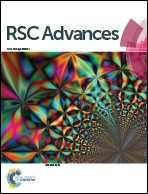Predicting aquatic toxicities of benzene derivatives in multiple test species using local, global and interspecies QSTR modeling approaches†
Abstract
Benzene derivatives (BDs) are widely used industrial chemicals and their toxic effects are well documented. The experimental toxicology being cost and time intensive, this emphasizes the need for the development of computational methods. In this study, we have established local and global quantitative structure–toxicity relationship (L-QSTR and G-QSTR) and interspecies correlation (ISC) based quantitative activity–activity relationship (QAAR) models for predicting the aquatic toxicities of BDs in single and multiple test species using the toxicity data in Tetrahymena pyriformis, Pimephales promelas, Poecilia reticulata, and Rana japonica in accordance with the Organization for Economic Cooperation Development (OECD) guidelines. The decision tree boost (DTB) and support vector machines (SVM) based models were constructed using molecular descriptors. The constructed models were validated using several statistical coefficients derived for the test data and the prediction and generalization abilities of these models were evaluated. In the L-QSTR and G-QSTR models, molecular weight was the most influential descriptor. The constructed L-QSTR (R2 > 0.896), G-QSTR (R2 > 0.846), and ISC QAAR (R2 > 0.754) models yielded considerably high correlations between the measured and model predicted endpoint toxicity values in the test data. The obtained results indicate the superiority of DTB based QSTR models over the SVM models. Furthermore, the chemical applicability domains of these models were determined via leverage approach. The results suggest for the appropriateness of the developed QSTR/QAAR models to reliably predict the aquatic toxicity of structurally diverse BDs and can be used for screening and prioritization of chemicals.


 Please wait while we load your content...
Please wait while we load your content...